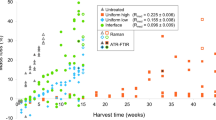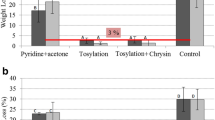Abstract
Acetylation is known to enhance the resistance of wood to brown rot fungi. As initial decay by some brown rot fungi is assumed to be caused by the Fenton reaction, pine micro-veneers acetylated to various weight percent gains (WPG) were exposed in a solution containing iron ions and hydrogen peroxide, i.e., Fenton’s reagent. Mass loss and tensile strength loss as well as the decomposition of hydrogen peroxide within the incubation time decreased with increasing WPG of the veneers. Incubation of untreated and acetylated veneers in acetate buffer containing ferric ions without H2O2 revealed that the modification strongly reduced the uptake of Fe ions by the wood cell wall. FT-IR analysis indicated oxidation of the unmodified control veneers but did not show predominant decay of specific cell wall components. Spectra of acetylated veneers did not reveal any significant changes induced by Fenton’s reagent. It was concluded that one possible reason for the enhanced resistance of acetylated wood to the Fenton reaction could be the reduced or almost completely prevented uptake of Fe ions by the wood cell wall.



Similar content being viewed by others
References
Ander P, Stoytschev I, Eriksson KE (1988) Cleavage and metabolism of methoxyl groups from vanillic and ferulic by brown-rot and soft-rot fungi. Cell Chem Technol 22:255–266
Arantes V, Goodell B (2014) Current understanding of brown-rot fungal biodegradation mechanisms: a review. In: Deterioration and Protection of Sustainable Biomaterials, vol 1158. ACS Symposium Series, vol 1158. American Chemical Society, pp 3–21
Arantes V, Qian YH, Milagres AMF, Jellison J, Goodell B (2009) Effect of pH and oxalic acid on the reduction of Fe3+ by a biomimetic chelator and on Fe3+ desorption/adsorption onto wood: implications for brown-rot decay. Int Biodeterior Biodegrad 63:478–483
Arantes V, Milagres AMF, Filley TR, Goodell B (2011) Lignocellulosic polysaccharides and lignin degradation by wood decay fungi: the relevance of nonenzymatic Fenton-based reactions. J Ind Microbiol Biotechnol 38:541–555
Cowling EB, Brown W (1969) Structural features of cellulosic materials in relation to enzymatic hydrolysis. Adv Chem Ser 95:152–187
Crestini C, Caponi MC, Argyropoulos DS, Saladino R (2006) Immobilized methyltrioxo rhenium (MTO)/H2O2 systems for the oxidation of lignin and lignin model compounds. Bioorg Med Chem 15:5292–5302
Crestini C, Crucianelli M, Orlandi M, Saladino R (2010) Oxidative strategies in lignin chemistry: a new environmental friendly approach for the functionalisation of lignin and lignocellulosic fibers. Catal Today 156:8–22
Enoki A, Tanaka H, Fuse G (1988) Degradation of lignin-related compounds, pure cellulose, and wood components by white-rot and brown-rot fungi. Holzforschung 42:85–93
Evans PD, Banks WB (1988) Degradation of wood surfaces by water. Changes in mechanical properties of thin wood strips. Holz Roh Werkst 46:427–435
Faix O (1991) Classification of lignins from different botanical origins by FT-IR spectroscopy. Holzforschung 45:21–27
Fenton HJH (1894) Oxidation of tartaric acid in presence of iron. J Chem Soc Trans 65:899–910
Filley TR, Cody GD, Goodell B, Jellison J, Noser C, Ostrofsky A (2002) Lignin demethylation and polysaccharide decomposition in spruce sapwood degraded by brown rot fungi. Org Geochem 33:111–124
Flournoy DS, Kirk TK, Highley TL (1991) Wood decay by brown-rot fungi: changes in pore structure and cell wall volume. Holzforschung 45:383–388
Goodell B, Daniel G, Jellison J, Nilsson T (1988) Immunolocalization of extracellular metabolites from Poria placenta. The International Work Group on Wood Preservation. Working Group IRG WP 1361
Goodell B, Jellison J, Liu J, Daniel G, Paszczynski A, Fekete F, Krishnamurthy S, Jun L, Xu G (1997) Low molecular weight chelators and phenolic compounds isolated from wood decay fungi and their role in the fungal biodegradation of wood. J Biotechnol 53:133–162
Green F (2000) Inhibition of decay fungi using cotton cellulose hydrolysis as a model for wood decay. Int Biodeterior Biodegrad 46:77–82
Green F, Highley TL (1997) Mechanism of brown-rot decay: paradigm or paradox. Int Biodeterior Biodegrad 39:113–124
Highley TL (1977) Requirements for cellulose degradation by a brown-rot fungus. Mater Org 12:25–36
Highley TL (1987) Changes in chemical components of hardwood and softwood by brown-rot fungi. Mater Org 22:39–45
Highley TL, Murmanis LL, Palmer JG (1983) Electron microscopy of cellulose decomposition by brown-rot fungi. Holzforschung 37:271–278
Hill CAS (2006) Wood modification—chemical, thermal and other processes., Wiley Series in Renewable Resources, John Wiley & Sons, Ldt, Hoboken
Hill CAS (2009) Why does acetylation protect wood from microbiological attack? Wood Mater Sci Eng 4:37–45
Hill CAS, Jones D (1996) The dimensional stabilisation of Corsican pine sapwood by reaction with carboxylic acid anhydrides. Holzforschung 50:457–462
Hill CAS, Jones D (1999) Dimensional changes in Corsican pine sapwood due to chemical modification with linear chain anhydrides. Holzforschung 53:267–271
Hill CAS, Khalil HPSA, Hale MD (1998) A study of the potential of acetylation to improve the properties of plant fibres. Ind Crop Prod 8:53–63
Hill CAS, Forster SC, Farahani MRM, Hale MDC, Ormondroyd GA, Williams GR (2005) An investigation of cell wall micropore blocking as a possible mechanism for the decay resistance of anhydride modified wood. Int Biodeterior Biodegrad 55:69–76
Hill CAS, Hale MD, Ormondroyd GA, Kwon JH, Forster SC (2006) Decay resistance of anhydride-modified Corsican pine sapwood exposed to the brown rot fungus Coniophora puteana. Holzforschung 60:625–629
Hosseinpourpia R, Mai C (2015) Degradation of wood polymer modified by low molecular weight phenol formaldehyde resin with Fenton’s reagent. Holzforschung. doi:10.1515/hf-2015-0045
Hosseinpourpia R, Adamopoulos S, Mai C (2015) Tensile strength of handsheets from recovered fibers treated with N-methylol melamine and 1,3-dimethylol-4,5-dihydroxyethyleneurea. J Appl Polym Sci. doi:10.1002/App.41290
Hyde SM, Wood PM (1997) A mechanism for production of hydroxyl radicals by the brown-rot fungus Coniophora puteana: Fe(III) reduction by cellobiose dehydrogenase and Fe(II) oxidation at a distance from the hyphae. Microbiology 143:259–266
Ibach R, Rowell RM (2000) Improvements in decay resistance based on moisture exclusion. Mol Cryst Liq Cryst 353:22–33
Kerem Z, Jensen KA, Hammel KE (1999) Biodegradative mechanism of the brown rot basidiomycete Gloeophyllum trabeum: evidence for an extracellular hydroquinone-driven Fenton reaction. FEBS Lett 446:49–54
Kirk TK (1975) Effects of a brown-rot fungus, Lenzites frabea, on lignin in spruce wood. Holzforschung 29:99–107
Kirk TK, Highley TL (1973) Quantitative changes in structural components of conifer woods during decay by white-rot and brown-rot fungi. Phytopathology 63:1338–1342
Kleman-Leyer KM, Agosin KE, Conner AH, Kirk TK (1992) Changes in molecular size distribution of cellulose during attack by white rot and brown rot fungi. Appl Environ Microbiol 58:1266–1270
Kleman-Leyer KM, Neil NR, Miller RC, Kirk TK (1994) Changes in the molecular-size distribution of insoluble cellulose by the action of recombinant Cellulomonas fimi cellulases. Biochem J 302:462–469
Klüppel A, Mai C (2012) Effect of lignin and hemicelluloses on the tensile strength of micro-veneers determined at finite span and zero span. Holzforschung 66:493–496
Koenigs JW (1972) Production of extracellular H2O2 and peroxidase by brown rot fungi. Phytopathology 62:100–110
Koenigs JW (1974) Fungal production of hydrogen peroxide in wood. Arch Microbiol 99:129–145
Koppenol WH, Liebman JF (1984) The oxidizing nature of the hydroxyl radical. A comparison with the ferryl ion. J Phys Chem 88:99–101
Kuo M, Stocke DD, Mcnabb HS (1988) Microscopy of progressive decay of cotton wood by the brown-rot fungus G. trabeum. Wood Fiber Sci 20:405–413
Law KN, Garceau JJ, Koran Z (1977) Measurement of intra-increment tensile-strength by using a zero-span technique. Wood Sci 10:42–48
Liese W (1970) Ultrastructural aspects of woody tissue disintegration. Ann Rev Phytopathol 8:231–258
Mai C, Majcherczyk A, Schormann W, Hüttermann A (2002) Degradation of acrylic copolymers by Fenton’s reagent. Polym Degrad Stab 75:107–112
Martínez AT, Rencoret J, Nieto L, Jimenez-Barbero J, Gutierrez A, del Rio JC (2011) Selective lignin and polysaccharide removal in natural fungal decay of wood as evidenced by in situ structural analyses. Environ Microbiol 13:96–107
Mohebby B (2008) Application of ATR infrared spectroscopy in wood acetylation. J Agric Sci Technol 10:253–259
Papadopoulos AN, Hill CAS (2002) The biological effectiveness of wood modified with linear chain carboxylic acid anhydrides against Coniophora puteana. Holz Roh Werkst 60:329–332
Papadopoulos AN, Hill CAS (2003) The sorption of water vapour by anhydride modified softwood. Wood Sci Technol 37:221–231
Pries M, Wagner R, Kaesler KH, Militz H, Mai C (2013) Acetylation of wood in combination with polysiloxanes to improve water-related and mechanical properties of wood. Wood Sci Technol 47:685–699
Qian Y, Goodell B, Felix C (2002) The effect of low molecular weight chelators on iron chelation and free radical generation as studied by ESR measurement. Chemosphere 48:21–28
Ringman R, Pilgård A, Brischke C, Richter K (2013) Mode of action of brown rot decay resistance in modified wood: a review. Holzforschung 68:143–255
Rowell RM (2004) Acetylation of natural fibers to improve performance. Mol Cryst Liq Cryst 418:881–892
Rowell RM, Banks WB (1987) Tensile-strength and toughness of acetylated pine and lime flakes. Br Polym J 19:479–482
Tarkow H, Stamm AJ, Erickson ECO (1946) Acetylated wood. Report, Forest Products Laboratory, USDA Forest Service 1593
Tarkow H, Feist WC, Southerland CF (1966) Interaction of wood with polymeric materials. Penetration versus molecular size. For Prod J 16:61–65
Thybring EE (2013) The decay resistance of modified wood influenced by moisture exclusion and swelling reduction. Int Biodeterior Biodegrad 82:87–95
Verma P, Dyckmans J, Militz H, Mai C (2008) Determination of fungal activity in modified wood by means of micro-calorimetry and determination of total esterase activity. Appl Microbiol Biotechnol 80:125–133
Wilcox WW (1978) Review of literature on the effects of early stages of decay on wood strength. Wood Fiber 9:252–257
Winandy JE, Rowell RM (1984) The chemistry of wood strength. In Rowell RM (ed) The chemistry of solid wood. ACS Sym Series 208, Washington DC, pp 211–255
Xiao Z, Xie Y, Mai C (2012) The fungal resistance of wood modified with glutaraldehyde. Holzforschung 66:237–243
Xie Y, Xiao Z, Goodell B, Jellison J, Militz H, Mai C (2010) Degradation of wood veneers by Fenton’s reagents: effects of wood constituents and low molecular weight phenolic compounds on hydrogen peroxide decomposition and wood tensile strength loss. Holzforschung 64:375–383
Xie Y, Xiao Z, Mai C (2015) Degradation of chemically modified Scots pine (Pinus sylvestris L.) with Fenton reagent. Holzforschung 69:153–161
Xu G, Goodell B (2001) Mechanisms of wood degradation by brown-rot fungi: chelator-mediated cellulose degradation and binding of iron by cellulose. J Biotechnol 87:43–57
Yelle DJ, Ralph J, Lu FC, Hammel KE (2008) Evidence for cleavage of lignin by a brown rot basidiomycete. Environ Microbiol 10:1844–1849
Acknowledgments
The authors would like to thank the German Academic Exchange Service (DAAD) for financial support.
Author information
Authors and Affiliations
Corresponding author
Rights and permissions
About this article
Cite this article
Hosseinpourpia, R., Mai, C. Mode of action of brown rot decay resistance of acetylated wood: resistance to Fenton’s reagent. Wood Sci Technol 50, 413–426 (2016). https://doi.org/10.1007/s00226-015-0790-0
Received:
Published:
Issue Date:
DOI: https://doi.org/10.1007/s00226-015-0790-0




